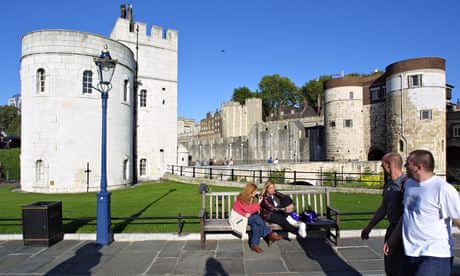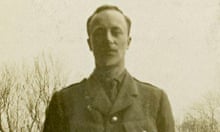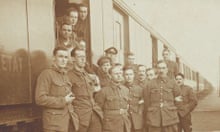One of the most famous stretches of open ground in Britain, the 16 acres of the Tower of London moat, will turn scarlet this August, planted with 888,246 ceramic poppies in memory of the British and Commonwealth dead of the first world war.
The poppies are being created by the ceramic artist Paul Cummins, inspired by a line in the will of a Derbyshire man who joined up in the earliest days of the war and died in Flanders.
"I don't know his name or where he was buried or anything about him," Cummins, who found the will among old records in Chesterfield, said. "But this line he wrote, when everyone he knew was dead and everywhere around him was covered in blood, jumped out at me: 'The blood-swept lands and seas of red, where angels fear to tread.' I believe he meant the angels to refer to his children."
Soldiers were encouraged to make simple wills, stored in their pocket books – often with moving last letters to their families - so they could be retrieved with their bodies if the worst happened.
Cummins, who is dyslexic, was moved by the shaky phonetic spelling and poor grammar in many of the wills composed by men who were barely literate – although the unknown soldier who inspired his art work wrote well, suggesting that he was a better off farmer or landowner.
The dead soldier - who never signed the will, which Cummins believes means his widow may never have got what little he left, and may even have lost custody of her children – will be among those commemorated in the sea of red ceramic poppies, one for every death among the British and Commonwealth forces between 1914 and 1921.
The dates underline the fact that the deaths did not end with the armistice in November 1918.
General the Lord Dannatt, who holds the ancient title of Constable of the Tower, recalled that many died of their war wounds in the following years. "It seems unreasonable to close the account arbitrarily on 11 November," he said.
The poppies, currently being hand made around the clock at Cummins' ceramics works in Derbyshire – "almost half a million finished, only another half million to go," he said cheerfully – will be planted by a small army of volunteers in the fortnight before 5 August, the centenary of the first full day of Britain's engagement in the war.
Within weeks of the declaration of war, the moat was in use as the training ground for the 1,600 men of "the stockbrokers' battalion", the bankers, lawyers, financiers and other City workers who signed up within one week, until the recruiting office had to be closed temporarily, overwhelmed by the numbers of volunteers.
"The term 'pals' battalion' hadn't been coined – but that was what the men who joined the City of London regiment of the Royal Fusiliers were, one of the very earliest," curator Sally Dixon-Smith said.
The City men called themselves the Ditchers, because they had joined up in the Tower ditch. The battalion was sent to France in July 1915, and would suffer 2,647 casualties over the next three years.
An exhibition at the tower this summer will record its wartime role, including the grimmest part of its service: the rifle range, which had been used for training and entertainment by the soldiers based there, became the execution ground where nine of 11 captured German spies were shot at dawn – the other two were shot in the moat itself.
The first to die was Carl Hans Lody, who wrote a letter on 5 November, the eve of his execution, to the commanding officer of the Grenadier Guards, thanking his men for looking after him so well.
"Although they never neglected their duty they have shown always the utmost courtesy and consideration towards me. If it is within the frame of reglements I wish this may be made known to them."
Dixon-Smith said even his interrogators were most impressed by Lody: "They felt he was unmistakably an officer and a gentleman, the right stuff."
The strangest part of the tower's wartime history was that it stayed open throughout as a tourist attraction: where visitors will stand in August looking down on the poppies, or gathering to hear the Last Post played at dusk each evening, their predecessors watched the new soldiers being trained before being shipped off to the front, many never to return.
The poppies will remain in place from 5 August until 11 November, and will then be sold for £25 each, which is planned to raise more than £15m for service charities.



